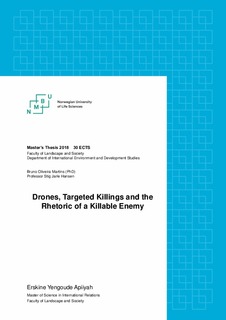| dc.contributor.author | Apiiyah, Erskine Yengoude | |
| dc.contributor.editor | Martins, Bruno Oliveira | |
| dc.contributor.editor | Hansen, Stig Jarle | |
| dc.date.accessioned | 2018-09-05T08:45:11Z | |
| dc.date.available | 2018-09-05T08:45:11Z | |
| dc.date.issued | 2018 | |
| dc.identifier.uri | http://hdl.handle.net/11250/2560850 | |
| dc.description.abstract | In the context of the international fight against terrorism, nations continue to target and kill people suspected of being terrorists or associated with terrorist networks. This war on terror has largely been driven by remotely piloted drones which is now a weapon of choice for western democracies. Although the legitimacy of targeted killing missions continues to be debated, these nations continue to make public justifications for eliminating suspected terrorists. The aim of this thesis was therefore to understand how western democracies framed their adversaries as targetable and killable as part of the global war on terror. Using the enemy image theory and US, Israel and UK as case studies, I explored the political discourse of these countries to understand how their political actors have justified suspected terrorists as killable targets. At the end of the study, my findings revealed that politicians use discursive devices that identify and polarize individuals and groups. The means of polarization involved the use of words that create a general divide between the self and the ‘Other’. Words that were degrading were peculiar to the ‘enemy’ whiles the complimentary imagery addressed the self or the state. Secondly, the political actors advanced the rhetoric to the projection of a threat that is existential and imminent in nature. The threat was framed in extra-ordinary terms out of normal politics such that, the threat situation required exceptional measures that included the killing of suspected terrorists. Finally, political actors emphasized the need and justifiable grounds for which the ‘enemy’ must be targeted and killed. This justification to kill the enemy was found to be normalized through the construction of the enemy in the political discourse. | nb_NO |
| dc.language.iso | eng | nb_NO |
| dc.publisher | Norwegian University of Life Sciences, Ås | nb_NO |
| dc.rights | Attribution-NonCommercial-NoDerivatives 4.0 Internasjonal | * |
| dc.rights.uri | http://creativecommons.org/licenses/by-nc-nd/4.0/deed.no | * |
| dc.subject | Western Democracies | nb_NO |
| dc.subject | Enemies | nb_NO |
| dc.title | Drones, targeted killings and the rhetoric of a killable enemy | nb_NO |
| dc.type | Master thesis | nb_NO |
| dc.description.version | submittedVersion | nb_NO |
| dc.description.localcode | M-IR | nb_NO |

